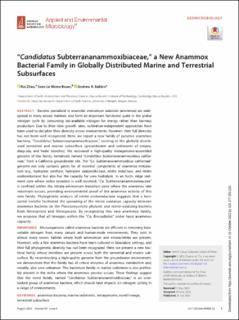| dc.description.abstract | Bacteria specialized in anaerobic ammonium oxidation (anammox) are widespread in many anoxic habitats and form an important functional guild in the global nitrogen cycle by consuming bio-available nitrogen for energy rather than biomass production. Due to their slow growth rates, cultivation-independent approaches have been used to decipher their diversity across environments. However, their full diversity has not been well recognized. Here, we report a new family of putative anammox bacteria, “Candidatus Subterrananammoxibiaceae,” existing in the globally distributed terrestrial and marine subsurface (groundwater and sediments of estuary, deep-sea, and hadal trenches). We recovered a high-quality metagenome-assembled genome of this family, tentatively named “Candidatus Subterrananammoxibius californiae,” from a California groundwater site. The “Ca. Subterrananammoxibius californiae” genome not only contains genes for all essential components of anammox metabolism (e.g., hydrazine synthase, hydrazine oxidoreductase, nitrite reductase, and nitrite oxidoreductase) but also has the capacity for urea hydrolysis. In an Arctic ridge sediment core where redox zonation is well resolved, “Ca. Subterrananammoxibiaceae” is confined within the nitrate-ammonium transition zone where the anammox rate maximum occurs, providing environmental proof of the anammox activity of this new family. Phylogenetic analysis of nitrite oxidoreductase suggests that a horizontal transfer facilitated the spreading of the nitrite oxidation capacity between anammox bacteria (in the Planctomycetota phylum) and nitrite-oxidizing bacteria from Nitrospirota and Nitrospinota. By recognizing this new anammox family, we propose that all lineages within the “Ca. Brocadiales” order have anammox capacity. | en_US |

